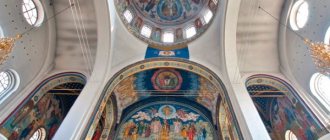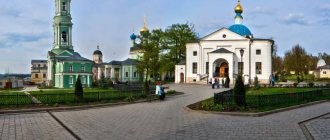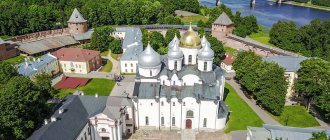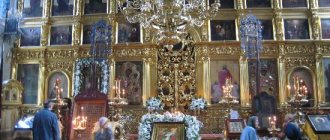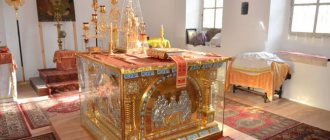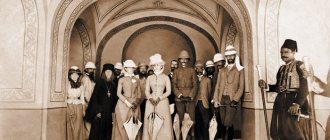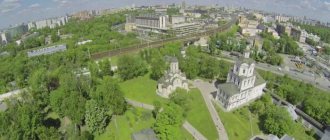According to church statutes, metropolis means a territory that serves the Lord under the command of a bishop - the main person in the Christian hierarchy. The diocesan administration of the Voronezh Metropolis unites under its authority all parishes and churches within the Voronezh region. This religious association was founded in 1682, and it received its current name in December 2013.
The churches of the Voronezh diocese exist under the leadership of Father Sergius (Vitaly Fomin), who was born in the mid-20th century in Krasnozavodsk. The saint became a monk after graduating from the theological academy, and as a metropolitan, he was appointed to the post of head of the diocesan administration.
Read about the churches and monasteries of Voronezh:
- Intercession Cathedral
- Divnogorsk Assumption Monastery
- Seraphim-Sarov Monastery
Annunciation Cathedral in Voronezh
History of the formation of the Voronezh Metropolis
Before the establishment of the Voronezh Metropolis, the area was used by the Ryazan and Krutitsa dioceses. The first was founded in 1667 after the Great Moscow Council. The Tambov diocese was placed within the Ryazan metropolis, and with it the Voronezh diocese, the need for the formation of which was confirmed at a church meeting. The structure of the latter initially included seven cities.
- In 1692, construction was completed on the territory of Voronezh
- Saint Mitrofan wisely disposed of the metropolis and strove to build a large number of churches; he arranged suitable living conditions for the monks and encouraged all kinds of charity.
- The borders of the diocese itself expanded to the Sea of Azov after Russian troops under the leadership of Peter I took the Azov fortress. On the conquered territory there were newly built cities that in the future had the right to enter the metropolis - Taganrog and Pavlovsk.
- On this basis, a dispute arose between the Ryazan church association and the Voronezh diocese; it was resolved by a decree of Tsar Peter the Great. The latter received at its disposal Usman, Belokolodsk, the village of Nikolskoye (Demshinsk), as well as the village of Mokry Buerak. After a while, the city of Ostrogozhsk also joined here.
- At the beginning of the 18th century, Saint Stephen tried to abolish the Voronezh diocese and return the territory of the Ryazan metropolis that belonged to it. However, this desire had the opposite effect. The Voronezh department acquired some areas of the Don and Khopra lands.
- Bishop Pachomius ordered great construction and restoration, and Metropolitan Joachim sought to exalt spiritual education by organizing church schools in Voronezh and Ostrogozhsk. Since 1742, a theological seminary and a Slavic-Latin school were opened on the territory of the diocese. In 1765, the metropolis again expanded its borders to include nearby lands, and Tikhon of Zadonsky strengthened moral motives among believers.
On a note!
The number of church institutions in the territory of the diocese gradually increased from 210 from the moment of its formation to 1096 in 1909. In 1945, only 19 parishes were in working order, today there are 372 of them. In 1775, part of the Moscow diocese was transferred to the administration of the Voronezh Metropolis, and the lands of the Azov region were given to the Slavic diocese. Over the course of 25 years, the territory of the first decreased somewhat; in 1799 there was not a single parish outside the province. In 1926, the Tambov Metropolitanate and Borisoglebsk were annexed to the diocese.
From 1954 to 1957, territorial changes continued to occur. In 2003, the Lipetsk Diocese was separated from the metropolis.
Iconostasis of the Annunciation Cathedral
News of the Orthodox world
Latest Orthodox news from Voronezh:
- On June 25, 2021, a service was held at the Cathedral, conducted by Metropolitan Sergius. After its completion, diplomas were awarded to graduates of the Voronezh Theological Seminary. This was the 111th graduation at the school, which brought together not only students and graduates of the religious educational institution, but also the entire teaching staff, as well as honored guests.
- On June 22, 2021, the Orthodox sports movement was created at the Tikhvin-Onufrievsky Cathedral. Any person who adheres to a healthy lifestyle, including sports and following God’s commandments, can become a participant in the movement. On Sundays in the church, clergy read prayers for the participants in the movement. After the service, conversations are held on spiritual and patriotic topics.
- On June 22, 2021, Metropolitan Sergius performed a litany for the fallen soldiers who gave their lives for the Voronezh region. The service took place at mass grave No. 6 in the city of Voronezh. This event was attended by not only priests, but also representatives of the regional government, the Veterans Council, and the city administration.
Current state
The territory of the Voronezh Metropolitanate was finally established in 2013.
It includes the following dioceses:
- Voronezhskaya.
- Rossoshanskaya.
- Borisoglebskaya.
On the territory of the region there are churches of the Voronezh Metropolitanate and churches of the Voronezh Diocese.
The Diocesan Administration of the Voronezh Metropolis is located at the address: Russia, Voronezh, st. Liberation of Labor, 20.
Currently there are 10 deaneries in the diocese:
- All Saints.
- Levoberezhnoe.
- Monastyrskoe.
- Nikolskoye.
- Kashirskoe.
- Liskinskoe.
- Nizhnedevitskoe.
- Novousmanskoe.
- Ramonskoe.
- Semilukskoe.
For reference!
Deaneries are church districts that unite a number of nearby parishes (they are governed by archpriests). On the territory of the metropolis there are one male and two female monasteries. Male: Holy Dormition Divnogorsk, near the town of Liski. Women's: Alexievo-Akatov and Preobrazhensky Tolshevsky.
Every week the Divine Liturgy is celebrated in churches.
The churches of the Voronezh Metropolitanate and other prayer rooms number 372. They are served by 382 clergy, of which 346 are priests, and 36 are deacons. On the territory of the diocese there is a theological seminary (rector - Abbot Innokenty), a traditional gymnasium of St. Mitrofan and a methodological department of moral education.
In the central city of the region, in Voronezh, there is an educational institution for training spiritual ministers - the Voronezh Orthodox Theological Seminary. This institution has its own official website on the Internet https://www.vob-eparhia.ru/, which is constantly updated with current information. On the website you can learn about the latest events in the life of the brotherhood and the decrees of the bishop.
There are also many printed publications - spiritual newspapers and magazines. Servants write articles on Internet portals and in newspapers (Orthodox Voronezh, Image of Life, as well as about 20 newspapers on religious topics). Within this church association, due attention is paid to working with young people.
An Orthodox magazine called “Way of Life” is officially considered a student magazine: on its pages the Church answers well-known questions of spiritual practice. The magazine combines ancient traditions and the opinions of modern Christians.
Metropolitan of Voronezh and Liskinsky Sergius
Every year, with the permission of Bishop Sergius, the Intercession Fair is held on Children's Square. Church items created in churches in Russia and the CIS countries are displayed here. The Voronezh diocese holds a festival of spiritual chants, as well as educational events and competitions among creative groups.
On a note! On the territory of the metropolis there is a special warehouse with church utensils and religious works of literature. Here Orthodox believers can buy candlesticks, stands for colored eggs, lamps, oil of oil and incense. Among the books are collections of biblical stories, prayer books, and lives of holy people.
general information
The current Voronezh Metropolitanate was created in 2013. The decision on its formation was made by the Holy Synod of the Russian Orthodox Church. It includes not only Voronezh, but also Rossoshansk and Borisoglebsk dioceses.
The heart of the metropolis is the Annunciation Cathedral, located in the center of Voronezh. The temple was built in the Russian-Byzantine style between 1998 and 2009.
The first service within its walls was held on the eve of the day of veneration of the Kazan Icon of the Mother of God. At the opening of the temple, Metropolitan Sergius served the festive Divine Liturgy.
Priests
The following people constantly serve in the Voronezh diocese:
- 15 hieromonks,
- 4 hierodeacons,
- 5 abbots and 2 abbess,
- 1 hieroschemamonk,
- 2 archimandrites,
- 46 archpriests,
- 101 priests,
- 23 deacons.
All clergy of the diocese are people worthy of emulation. They have given their lives and destiny to the power of the Lord and rely only on him. The clergy left worldly life and the temptations of the modern world behind the walls of the Church. Their destiny is prayer and service to God.
Expansion after the capture of Azov
The boundaries of the department expanded to the Sea of Azov after the capture of the Azov fortress in 1696. The new cities of Taganrog and Pavlovsk were under its jurisdiction. After a dispute in 1699 over territory with the Ryazan bishop, which was resolved by Emperor Peter I, the cities of Belokolodsk, Ostrogozhsk, Usman, Demshinsk and the village of Mokry Buerak began to belong to the Voronezh diocese.
In 1712-1714, Metropolitan Stefan of Ryazan wanted to abolish the Voronezh diocese and return its territories to the Ryazan department, but to no avail.
In 1718-1720, the diocese expanded even more, now it included the territories adjacent to the Khoper and Don rivers. The restoration of the main cathedral, which was begun by Metropolitan Pachomius, lasted until 1735. Under Bishop Joachim
Schools are organized for children of clergy in Voronezh and Ostrogozhsk.
Nowadays
Today the diocese has ten deaneries (districts that combine several parishes located close to each other). Among them: Voronezhsky, Liskinsky, Kashirsky and others. They are headed by clergy - archpriests and hieromonks, called deans.
The department is headed by Father Sergius. It has an official website where you can get acquainted with the life of the diocese, news, and decrees of the metropolitan.
The diocese includes monasteries located in Voronezh and the region:
- Male - Holy Dormition Divnogorsk, located in the village of Divnogorye.
- Women's - Alexievo-Akatov and Preobrazhensky Tolshevsky.
Every week in 148 temples it is performed. There are 278 clergy, including 245 priests and 33 deacons. And also in the Voronezh diocese in Voronezh there is a theological seminary and an Orthodox gymnasium.
News on the site
Among the news published on the official website, there are those that may primarily be of interest to the younger generation. By decree and with the blessing of Metropolitan Sergius, an exhibition-fair called Pokrovskaya is being held in Voronezh from October 13 to 18.
She settled down in the palace
creativity of children and youth, located on Children's Square, No. 1. It presents products produced in churches and monasteries in Russia, as well as in countries near and far abroad. Here you can find literature for children and educational purposes.
Here's another interesting news. These days, the festival of spiritual songs “Ark” is also held, which is the author’s own. In addition, spiritual and educational events are held. These are competitions, master classes and performances of creative groups - choral and musical.
Decrees of the diocesan administration
The latest decrees are dated March 2021:
- By Decree No. 85 of 03/23/2017, G.S. Avetisov is appointed chairman of the Parish Council of the church consecrated in honor of the icon of the Mother of God “The Unbreakable Wall”. The term of appointment is 3 years.
- By Decree No. 82 of 03/22/2017, clergyman Pavel Nikolaevich Nebolsin is relieved of the post of chairman of the Parish Council of the temple, consecrated in the name of St. Nicholas the Wonderworker.
- Decree No. 80 of March 15, 2017 to Deacon Baranov N.V. Priesthood is prohibited for up to 3 months. With the blessing of the metropolis, he must carry out choir obedience every day in the Church of the Holy Life-Giving Trinity.
Note!
Each decree is considered by the diocesan administration and adopted with the consent of Metropolitan Sergius of Voronezh.
Let's sum it up
The Voronezh Metropolitanate is the spiritual center of Voronezh and the region. This is a church organization that manages all the churches, communities and monasteries that exist in the region.
He decided to raise the Ryazan Archdiocese to the status of a metropolitanate and create two dioceses within it - Tambov and Voronezh. The need to open the Voronezh diocese was also confirmed by the Moscow Council of 1681-1682. The department was established on November 27, 1681 and replaced by the installation of St. Mitrofan on April 2, 1682.
Initially, the diocese included the cities of Voronezh, Yelets, Kostensk and Orlov from the Ryazan diocese; Uryv, Korotoyak and Zemlyansk from the Belgorod diocese. In 1692, the Annunciation Cathedral was completed in Voronezh. Under Saint Mitrofan, many churches were built, monastic life and charity were organized.
In 1700-1704, the Azov diocese in the newly annexed southern lands was briefly separated from the Voronezh diocese.
In 1712-1714, the locum tenens of the patriarchal throne of Ryazan, Metropolitan Stefan (Yavorsky), unsuccessfully tried to abolish the Voronezh diocese and return the territory to the Ryazan department. Contrary to this, the region of the Voronezh diocese was expanded even more - in 1718-1720, lands along the Don and Khoper rivers were transferred from the Patriarchal region, and in 1720 parts of the Ryazan see were annexed. Metropolitan Pachomius (Shpakovsky) launched large-scale construction work; the restoration and reconstruction of the cathedral continued until 1735. Bishop Joachim (Strukov) paid a lot of attention to spiritual education - under him, schools were organized for the children of clergy in Voronezh at the bishop's house and in Ostrogozhsk. Under subsequent rulers, a Slavic-Latin school was opened at the Divnogorsk Assumption Monastery in 1742, and on May 31, 1745, the Voronezh Theological Seminary was opened. In 1749, part of the lands of the Tambov diocese came under the jurisdiction of the Voronezh See, but in 1758 these lands again went to the renewed Tambov See. In 1765, the Voronezh diocese expanded to include part of the Krutitsa, Kolomna and Ryazan dioceses. The priesthood of Tikhon of Zadonsk in 1763-1767 strengthened the spiritual and moral foundations of life in the diocese, primarily in monasteries.
In 1799, the boundaries of the dioceses were brought into line with the boundaries of the provinces; all lands outside the Voronezh province were transferred to other departments.
In 1829, Novocherkassk was separated from the Voronezh diocese.
As of January 1, 1917, there were 1,128 churches in the diocese, of which 983 were parish (the rest were house, monastery, and cemetery). 52 churches were built, 16 were built but not consecrated, and 3 new churches were consecrated in 1916. 1,221 priests, 295 deacons and 1,230 psalm-readers served in the churches and monasteries of the diocese.
In 1926, the territory of the Tambov diocese with the city of Borisoglebsk joined the Voronezh diocese. In 1934, part of the Voronezh diocese, including the newly formed Belgorod region, went to the Kursk See. In 1954, the Voronezh diocese included the territory of the newly formed Lipetsk region; The lands of the newly formed Balashov and Kamensk regions were transferred to the Saratov and Rostov dioceses. In 1957, the last two regions were disbanded, their territories returned to the Voronezh diocese.
On May 7, 2003, the Lipetsk diocese was separated from the Voronezh diocese within the Lipetsk region, at the same time the Voronezh diocese was limited to the Voronezh region.
By the decision of the Holy Synod of December 25-26, 2013 (magazine No. 137), the Borisoglebsk and Rossoshansk dioceses were separated from the diocese. The Voronezh diocese is included in the Voronezh Metropolitanate. The Synod decided to call the ruling bishop "Voronezh and Liskinsky".
The Voronezh Metropolis was founded on December 26, 2013 on the territory of the Voronezh region. The Metropolis belongs to the Russian Orthodox Church and includes not only the Voronezh, but also the Rossoshansk and Borisoglebsk dioceses.
In the modern Orthodox Church, metropolitan denotes the territory governed and where the metropolitan constantly serves - the bishop, who is one of the main figures in the church hierarchy
.
Start
The territory of the province in all church affairs until 1682 was subordinated to the Ryazan and Krutitsa dioceses. But in 1667, the Great Moscow Council adopted a decree on the transfer of the Ryazan Archdiocese to the status of the Ryazan Metropolis and the establishment of the Tambov and Voronezh dioceses within it. The Moscow Council of 1682, by its decree, approved the need to create and open the Voronezh diocese.
Initially into it
included 7 cities: Voronezh, Zemlyansk, Yelets, Orlov, Kostensk, Korotoyak, Uryv. In 1692, the main temple of Voronezh, the Annunciation Cathedral, was completed. Many churches were built under St. Mitrofan. And also under him, life and charitable activities were improved.
Official site
The Voronezh diocese has its own website, located at: www.vob-eparhia.ru, developed in 2011.
Here you can find the latest and most relevant information regarding the activities of the Metropolitanate in Voronezh and the region. All information is constantly updated and expanded.
The official website of the diocesan administration includes the following information:
- decrees adopted by the diocesan administration of Voronezh and signed by Metropolitan Sergius;
- the Metropolitan's appeal to Orthodox Christians;
- Metropolis News Today;
- documentaries about the life of the metropolis;
- News archive;
- information about the holy ascetics of the diocese;
- contacts.
Newspapers and magazines
Among the diocesan publications there are those published on the Internet and print media.
The first include:
- Official website of the diocese.
- Theological seminary website.
The second ones include:
- Quarterly review “Orthodox Voronezh”.
- Magazine "Diocesan Bulletin of Voronezh".
- Journal of the Theological Seminary “Way of Life”.
- More than 20 newspapers and supplements to them, having a spiritual and educational character.
The Voronezh diocese pays great attention to working with young people. Lifestyle Magazine is an Orthodox student magazine. It is intended for young readers
who are thoughtful and inquisitive. In it, the church answers more and more new questions regarding spiritual life. This publication combines Russian socio-religious traditions and the views of modern Christians on current issues in the life of the church and parishioners.
Further reorganization
In 1742, a Slavic-Latin school was opened in the Divnogorsk Assumption Monastery, and in 1745, the Voronezh Theological Seminary. In 1765, territories previously belonging to the Ryazan, Kolomna and Krutitsa dioceses were annexed. In 1755, part of the Moscow diocese came under the jurisdiction of the Voronezh diocese, and the lands of the Azov region were transferred to the newly created Slavic diocese.
In 1788 most of the northwestern and northern
The lands of the Voronezh see, which are more than 400 churches and several monasteries, are transferred to the jurisdiction of neighboring dioceses. By the end of the 18th century, all the boundaries of the dioceses began to correspond to the boundaries of the provinces, and all lands belonging to the Voronezh diocese, but located outside the province, were transferred to other dioceses.
Stock
The Voronezh diocese has its own warehouse with various Orthodox-themed goods. You can order them on any weekday. The diocese warehouse offers Orthodox books and church utensils.
Here you can buy books about the lives of Christian saints, on the History of the Orthodox Church, prayer books, theological prose and poetry, books about gardening and publications with culinary recipes.
Opening hours of the warehouse of the Voronezh diocese:
- Monday – Friday from 10:00 to 17:00 – dispatch of ordered goods;
- Saturday, Sunday, twelve holidays - days off.
Note!
You can place an order for Orthodox goods directly on the warehouse website.

